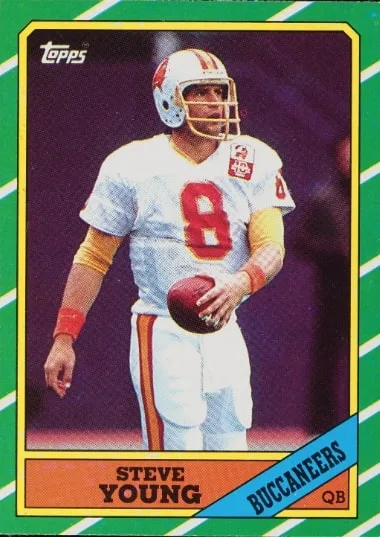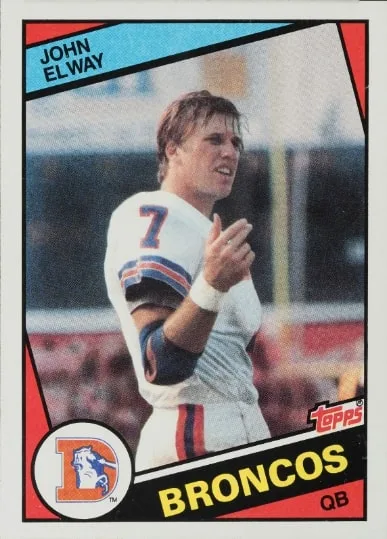
How Cards Helped the NFL Go Big
Although the NFL can trace its lineage to 1920, the consensus has been that it did not make much of a splash in American culture until the dramatic 1958 championship game between the Baltimore Colts and the New York Giants. But a look at football card history suggests an earlier date, as Bowman began printing cards in 1948, and Topps carried the torch starting in 1956, suggesting that there must have been sufficient interest in the sport to justify distribution.
It’s a perfect example of how card companies anticipate and influence the direction of American sports culture. Baseball fans have known the appeal of superstars from the time of Ty Cobb and Babe Ruth, and it seems plausible that the sports card industry helped to anchor those iconic personalities in fans’ minds.

1948 Bowman Football #22 Sammy Baugh

1954 Bowman Football #23 George Blanda
Future Football Hall of Famers like Sammy Baugh and Sid Luckman appeared in the 1948 Bowman set, and standout rookie cards for stars like Frank Gifford (1952 Bowman #16) and George Blanda (1954 Bowman #23) have retained value since they were printed. But it was the iconic 1957 Topps set that created space in the American imagination for the rise of the football superstar.
1957 Topps Football
With 154 cards in the set, the 1957 Topps Football set anticipated an explosion of interest in the sport, eventually leading to football rivaling baseball for the claim of being America’s pastime. The set was released in two series, with cards #89-154 being slightly more scarce than low number cards. Of the 154 players included in the set, 35 would be inducted into the Hall of Fame.

1957 Topps Football #138 John Unitas

1957 Topps Football #119 Bart Starr
The most notable two cards in the 1957 set are the respective rookie cards for Bart Starr (#119) and Johnny Unitas (#138). The Unitas card was double-printed, making it somewhat less rare, but both cards have sold in the six-figure range at PSA-9 in recent years. By the time his career concluded, Unitas had appeared in ten Pro Bowls, racked up more than 40,000 Yards, and won three MVP awards. The figure of “the superstar quarterback” has been an American archetype ever since.
Other standout cards in the 1957 set include rookie cards for Dick “Night Train” Lane (#85), Raymond Berry (#94), and Paul Hornung (#151). As remarkable as it sounds, by printing full-color cards featuring action photos and clear portraits, the 1957 Topps set solidified the idea of the football superstar in the minds of American fans.
Notable Golden Age Football Rookies
One of the most prized cards in football history is the 1958 Topps Jim Brown rookie card (#62). Having won Rookie of the Year in 1957, Brown went on to win three MVP awards. Because the card was commonly printed with poor centering and was susceptible to chipping along the edges, it can be valued very highly when found in mint or near-mint condition.

1958 Topps Football #62 Jim Brown

1962 Topps Football Mike Ditka #17
The 1962 Topps set included two important rookie cards: Mike Ditka (#17) and Fran Tarkenton (#90). Ditka was Offensive Rookie of the Year in 1961 and was the NFL’s first superstar tight end. Tarkenton’s Hall-of-Fame career at quarterback with Minnesota saw him throw for over 47,000 yards and included 33 game-winning drives.
The 1965 Topps set is notable for the inclusion of four rookies whose cards were all short-printed. Fred Biletnikoff (#133), Willie Brown (#46), and Ben Davidson (#137) are desirable for this reason, but the Joe Namath rookie card (#122) was also short printed in 1965, and that has made it one of the most elusive and valued cards in football history.

1965 Topps Football #122 Joe Namath
Topps produced notable rookie cards in the 1970s for O.J. Simpson, Terry Bradshaw, and Walter Payton. Between 1956 and 1976, Topps cards elevated the sport to a central place in the American imagination, as much as television and perhaps more than newspapers. The inclusion of personal anecdotes and statistics helped transform fine athletes into superstars and commodities.
Later Key Cards and the Return of Topps Football
Later cards, such as Steve Largent’s 1977 Topps rookie card (#177) and Joe Montana’s 1981 rookie card (#21), have retained significant value. By the mid-1980s, football cards, like baseball cards, were printed and collected in greater numbers, and there has been a sense that cards printed after the mid-1980s are less in-demand.
In response, hobbyists have emphasized the importance of condition. Roughly 32,000 1986 Jerry Rice rookie cards are in circulation, but fewer than 100 have been graded PSA 10. Other important cards from the late 1980s include the 1986 Steve Young rookie card (#374) and the 1988 Bo Jackson rookie card (#327).

1986 Topps Football #161 Jerry Rice

1986 Topps Football #374 Steve Young
Rookie cards in 1984 for John Elway #63 and Dan Marino #123 are similarly widely available but can demand premium prices at grade PSA-10. As football entered the 1990s, interest in the sport hit all-time highs, and the card market became somewhat oversaturated.

1984 Topps Football #63 John Elway

1984 Topps Football #123 Dan Marino
Topps has not produced full sets of NFL football cards since the 2015 season, but its Bowman Chrome U line has been well-received since 2021. Additionally, the 2023 Topps Composite Football set, released August 30, is worth a serious look. Looking forward to 2025, Topps will have exclusive printing rights for NFL cards, and hobbyists are already anticipating a football card renaissance under the new agreement.
As the 2024-2025 NFL season kicks off, thanks in large part to card companies and collectors’ interest, the appreciation of football superstardom is greater than ever. The numbers posted by modern athletes have outstripped even the best of the stars from the 1960s. Still, the old cards serve as a kind of anchor for the sport, and comparison goes hand-in-hand with joy when it comes to sports history.